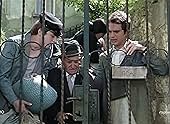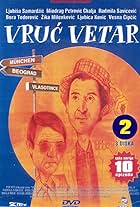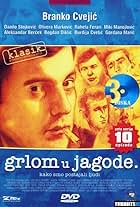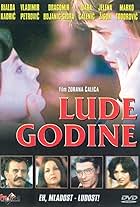Otpisani
- Serie TV
- 1974–1975
- 55min
VALUTAZIONE IMDb
8,5/10
1830
LA TUA VALUTAZIONE
Aggiungi una trama nella tua linguaPrle, Tihi, and other youths from the resistance movement in German-occupied Belgrade are high on the Gestapo's termination list. Some of them get written off, but new ones arrive and contin... Leggi tuttoPrle, Tihi, and other youths from the resistance movement in German-occupied Belgrade are high on the Gestapo's termination list. Some of them get written off, but new ones arrive and continue to fight.Prle, Tihi, and other youths from the resistance movement in German-occupied Belgrade are high on the Gestapo's termination list. Some of them get written off, but new ones arrive and continue to fight.
Sfoglia gli episodi
Trama
Lo sapevi?
- QuizHas some similar plot points and cast with Operacija Beograd (1968).
- ConnessioniFeatured in Robna kuca: Otpisani (2009)
Recensione in evidenza
Nowadays, over thirty years since "Otpisani" (aka "The Written-Off", a Serbian TV production, 1974) hit the Yugoslav screens, it is difficult to grasp the magnitude and the impact the series had on generations of Yugoslav viewing public. It went on to become a smash hit at the time, spawning a full length feature film (basically a re-edit of the material filmed for the TV series) and a sequel, "Povratak otpisanih" (The Return Of The Written-Off), two years later - the whole package achieving genuine cult status. The reasons for such a comprehensive success were numerous - it was chronologically the first attempt to present a then-favourite Yugoslav film subject - World War II and the antifascist struggle across the country, in those days still reverently depicted with pathos and due "grandeur" - in a new, much more youthful, accessible and hipper style than was ordinarily the case. Moreover, it told a story of urban anti-German resistance in occupied Belgrade of the early forties, as opposed to bulky, dated and myth-ridden film productions about Tito's partisan movement which domineered the Yugoslav cinema in the decades following the war. Most importantly, "Otpisani" rounded up a young, urban, good looking and charismatic cast which were able to convincingly carry off this new approach (most of the leading actors involved since achieved long running and successful careers in film, theatre and TV, some of them - most notably Miki Manojlovic - acquiring international recognition). Incidentally, four of the main leads (Manojlovic, Dragan Nikolic, Voja Brajovic and Aleksandar Bercek) can be seen together in Goran Paskaljevic's award winning and Altmanesque "Bure baruta" (aka "The Powder Keg", also known as "Cabaret Balkan", 1998), each one of them asserting the longevity and endurance of their respective acting careers.
Viewed today, some aspects of the production on "Otpisani" reveal themselves in their weakness. In particular, the writing remains problematic, despite the dialogue being given a more-realistic-than-usual sheen. The characterisation is mostly rigidly monochrome, strictly goodies vs baddies (some would say very cowboys'n' indians alike, an obvious American film influence), and most of the thirteen filmed episodes tend to sleepwalk through their individual plots before resolving themselves in spectacular, pyrotechnic-galore, sometimes tragic finales. However, the series makes great use of authentic Belgrade locations, both its numerous posh districts and grand interiors as well as seventies' demolition sites serving as perfect film sets for the lovingly built city which was mercilessly pounced upon during WWII. The grainy black & white photography contributes to achieving the look and the feel of the times, helped greatly by Milivoj Markovic's energetic and memorable music score (itself heavily influenced by Isaac Hayes' "Shaft" soundtrack as well as Lalo Schiffrin's tense atmospherics - another novelty in Yugoslav film and telly). In short, "Otpisani" was a breakthrough TV production which introduced many young acting talents and spoke in a visual language which resonated far better with the changing demands of the viewing public, younger generations in particular. Fun viewing, even today.
Viewed today, some aspects of the production on "Otpisani" reveal themselves in their weakness. In particular, the writing remains problematic, despite the dialogue being given a more-realistic-than-usual sheen. The characterisation is mostly rigidly monochrome, strictly goodies vs baddies (some would say very cowboys'n' indians alike, an obvious American film influence), and most of the thirteen filmed episodes tend to sleepwalk through their individual plots before resolving themselves in spectacular, pyrotechnic-galore, sometimes tragic finales. However, the series makes great use of authentic Belgrade locations, both its numerous posh districts and grand interiors as well as seventies' demolition sites serving as perfect film sets for the lovingly built city which was mercilessly pounced upon during WWII. The grainy black & white photography contributes to achieving the look and the feel of the times, helped greatly by Milivoj Markovic's energetic and memorable music score (itself heavily influenced by Isaac Hayes' "Shaft" soundtrack as well as Lalo Schiffrin's tense atmospherics - another novelty in Yugoslav film and telly). In short, "Otpisani" was a breakthrough TV production which introduced many young acting talents and spoke in a visual language which resonated far better with the changing demands of the viewing public, younger generations in particular. Fun viewing, even today.
I più visti
Accedi per valutare e creare un elenco di titoli salvati per ottenere consigli personalizzati
- How many seasons does Otpisani have?Powered by Alexa
Dettagli
- Data di uscita
- Paese di origine
- Lingua
- Celebre anche come
- Списаны
- Luoghi delle riprese
- Azienda produttrice
- Vedi altri crediti dell’azienda su IMDbPro
- Tempo di esecuzione55 minuti
- Colore
- Mix di suoni
Contribuisci a questa pagina
Suggerisci una modifica o aggiungi i contenuti mancanti

























